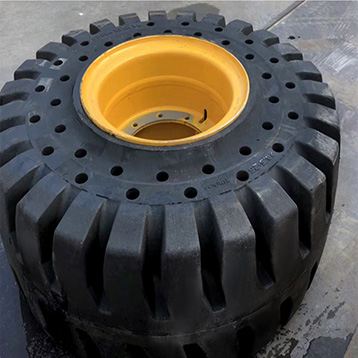Skid steer loaders, known for their versatility and compact design, are essential machinery in a variety of industries such as construction, landscaping, agriculture, and warehousing. One of the critical components of these machines is the tire, which directly impacts performance, safety, and operational efficiency. Skid steer solid tires have undergone significant advancements over the years to meet the evolving demands of modern-day applications.

In the early years of skid steer loader development, pneumatic tires were the go-to option, similar to those used in traditional vehicles. These tires offered a reasonable balance of comfort, traction, and shock absorption, which were necessary for the performance of skid steer loaders. However, pneumatic tires also had several drawbacks that led to the rise of solid tires.
Pneumatic tires are prone to punctures, especially when working in environments filled with sharp debris, such as construction sites or demolition zones. Furthermore, they require regular maintenance, including air pressure monitoring, tire balancing, and occasional repairs. This made pneumatic tires less reliable and more costly over the long term, particularly for equipment used in demanding, high-performance environments.
As a result, manufacturers and operators began seeking alternatives that would offer greater durability and reduced maintenance requirements. This led to the rise of solid tires, which were designed to eliminate the vulnerabilities associated with pneumatic tires. Solid tires provided a more robust, flat-proof solution, which made them ideal for the rough terrains and high-impact conditions skid steer loaders frequently face.
One of the notable changes in the development of skid steer solid tires was the improvement in materials. Early solid tires were made primarily from rubber compounds, similar to their pneumatic counterparts, but lacked the sophistication in design and performance that later versions would offer.
Over time, advancements in rubber compounding and tire manufacturing technology led to the development of more durable and long-lasting solid tires. Modern solid tires are often constructed from a combination of high-quality rubber and synthetic materials, such as polyurethane and specialized polymers. These materials are engineered to resist wear, provide traction, and maintain performance even in conditions.
The introduction of advanced tread designs has also played a role in enhancing the overall performance of solid tires. Manufacturers began experimenting with different tread patterns to provide improved grip, stability, and control. For example, some solid tires are designed with a deep, aggressive tread that excels in loose, sandy, or muddy conditions, while others have smoother treads for use on hard surfaces such as concrete or asphalt. These innovations have made solid tires suitable for a wide range of applications, further solidifying their place as a preferred choice for skid steer loaders.
Another critical factor in the evolution of skid steer solid tires has been the increase in load capacity and overall stability. Skid steer loaders are often tasked with lifting and transporting heavy loads, and tires must be able to withstand the associated stresses without compromising safety or performance.
In the early stages of solid tire development, the load-bearing capabilities of the tires were somewhat limited, and operators often had to deal with issues such as tire deformation under heavy loads. However, with advances in tire design, including the introduction of stronger sidewalls, reinforced structures, and better weight distribution, modern solid tires are capable of supporting significantly higher loads. This improvement in load capacity has allowed skid steer loaders to be used for more demanding tasks, including heavy-duty lifting, excavation, and material handling.
 View More
View More
 View More
View More
 View More
View More
 View More
View More
 View More
View More
 View More
View More
 View More
View More
 View More
View More
 View More
View More
 View More
View More
 View More
View More
 View More
View More